Seldom does one size fit all, and the same goes for whether or not one type of life jacket can meet all lifesaving needs.
The backstory behind this fresh look at life jacket design stems from how fashion and function have merged and market focus has zoomed in on inflatables. Many find inflatable harness-vest to be a sensible compromise because a life jacket left in a locker isn’t much help at all. But the question remains, can one personal floatation device (PFD) work well in all circumstances? There’s a long list of life jacket design issues to consider. For example, a device that expedites the rescue of a person bobbing about on a calm, flat sea may be very different from what’s needed to survive being washed through the surf zone.
A positive ongoing theme in the sailing community has been an effort to increase the number of sailors wearing life jackets. And for offshore sailing, the inflatable PFD has become the life jacket of choice. Unfortunately, over enthusiasm about one product can sideline other useful equipment, or in some cases, even denigrate better equipment. There are some legitimate concerns over the view that the inflatable life jacket is the perfect fit for offshore sailors. Don’t get me wrong, I’m an advocate of inflatable life jackets; I own and use several different brands, but I also recognize that there are some inherent shortfalls in the technology.
One the biggest concerns, is that in its very comfortable deflated mode, it offers less lifesaving buoyancy than a pair of worn out flip-flops. And when you need floatation most, that buoyancy must arrive quickly, if not instantaneously. The auto-inflation gamble can span a range that goes from a few seconds to never. In our last year’s report, (see PS July 2019, “Rethinking the Inflatable PFD”) we detailed how to hedge your bets and improve the odds for a rapid arrival of lifesaving buoyancy. There are guidelines about what to do if the auto feature fails and why blowing up the bladder orally, while gasping for air, in cold water, on a dark night—is truly a last resort.
Despite this fallibility, we hear inflatable advocates and safety experts go on record with comments like, “if you buy a USCG-approved inflatable life jacket you won’t have to bother carrying one of those bulky, space wasting type I, II or III life jackets.” This assumes that the all-important inflation process will occur near instantaneously, and that the PFD’s thin bladder skin, sealed seams, and hardware will always remain intact. The evolution of inflatable life jackets as the rock star of safety afloat, has been troubled by inflator malfunctions, bladder seam failures, and corrosion caused by poor maintenance.
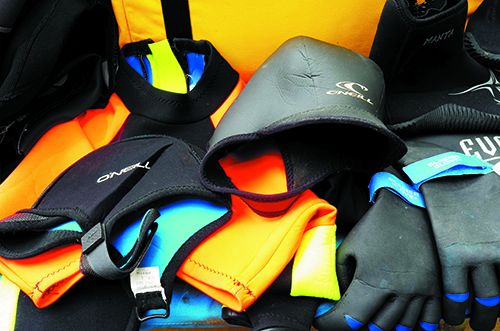
Expert advice
Mark Bologna is a safety expert on and off the water. He sells, rearms and advises clients at Landfall Navigation and helps train participants with safety training programs up and down the east coast. I recently asked Mark for a comment about inflatables vs. foam life jackets. He wrote the following summary for PS offering thoughtful insight from a pro’s perspective on why there’s reason to wear an inflatable life jacket while sailing and to also keep a Type 1 PFD onboard and ready:
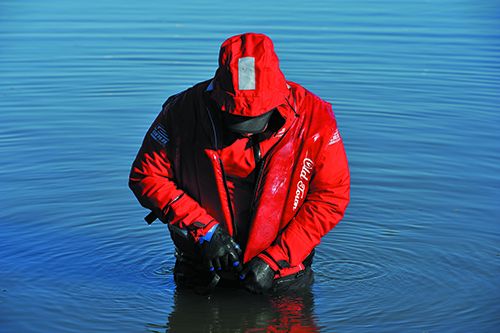
“Most agree that as good as inflatable PFD’s have become, they are not infallible. Each must be regularly inspected and maintained. Foam PFD’s on the other hand, have no mechanical mechanism that can malfunction. They are inherently buoyant and do not require an auto or manual inflation system to develop buoyancy. The closed cell foam life jacket cannot be rendered inoperable by being punctured or damaged by floating debris. And they will always work if stored and donned properly.
“The reason we wear inflatable PFD’s is freedom of movement, they are less restrictive than foam PFD’s, which are more cumbersome when moving about and working on deck. Inflatable PFD’s protect us from drowning when knocked overboard, because we have them on. If the need arises to abandon ship due to fire, uncontrollable flooding or grounding on a lee shore and time permits; nothing says you can’t switch out of your inflatable and don your Type I life jacket.”
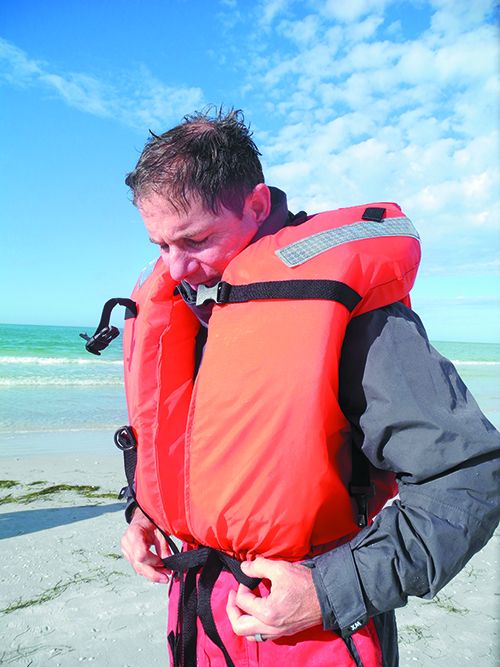
Mark’s logic dovetails with ours. We agree that one of the big pluses of inflatable life jackets is that they are more likely to be worn, which means that it’s more likely that a person-in-the-water (PIW) will have floatation. Abandoning ship is a different scenario. Floatation is vital, but equally important is retention of that buoyancy regardless of impacts from waves, sharp edges, dismasted rigging and other hazards to the air bladder. A USCG Type I or SOLAS-approved, closed cell foam life jacket delivers a 100 percent chance of immediate lifesaving buoyancy, is much more immune to damage, and remains the Coast Guard’s recommendation for use in extreme conditions.
Abandoning ship
Deciding when to abandon a vessel that’s grounded, flooding and swept by surf involves some waterman’s survival instincts. The route to safety may be a circuitous one. It might necessitate swimming parallel to, rather than toward the beach, in order to get out of a gutter rip where a seaward setting current makes progress toward shore impossible. When one can swim directly toward shore, they will be both helped and hampered by whatever PFD they happen to be wearing. That’s why getting to know how to swim wearing a life jacket is so important.
It can become life threatening if one’s sprint for shore coincides with the largest waves of a set. In this case timing is everything. Surfers who sit in a lineup, waiting for a favorable peak, know a thing or two about oceanography and the energy transferred between a wave and a shoal or reef. What the sailor needs to learn is the opposite of what the surfer is looking for. The sailor is looking for the energy nadir rather than its zenith
Breaking waves are an amalgam of distant swells and closer, short period wind waves that combine into greater or lesser amounts of energy. The larger sets (more resonance—greater amplitude) are often regularly interspersed with lulls. These periods of smaller waves are the best bet for a PIW hoping to reach shore with the least amount of “over-the-falls” action. As one lines up for the safest transit through the surf zone, it makes sense to get a feel for where the bigger sets are breaking hardest and how long the lull presides between sets. The time to get going is just as the big ones subside and the fickle lull period begins.
Get to know your life jacket from an in-the-water perspective. Spend some time floating around in a flat calm. Experiment with what swimming technique works best. Try out a type I PFD and you’ll probably discover that your most mobile swim is linked to a strong frog kick and a breast stroke. Most sailors discover what divers have known for decades, and that’s swim fins are a big asset. A waterman knows the value of a pair of small, body surfing/boogie boarding fins such as the old standby Churchill Makapuu fins. They also favor a quick to slip on a neoprene Shorty or Farmer John wetsuit that helps stave off hypothermia, lessens injury from abrasive surfaces and retains mobility and flexibility.
If you ever face a grounding in the surf zone and the need to swim to shore, you’ll improve your survival chances by donning a wet suit, booties, hood and a type I PFD. Grab the small, easy to slip-on swim fins and carefully enter the water avoiding immersed rigging and the pounding hull. Time your swim to safety so it takes advantage of the lull between sets. Beware of offshore moving rip currents that can make progress impossible. A self-rescue through the surf zone is a different kind of victim response than what’s done in an underway MOB where signaling efforts are prioritized.
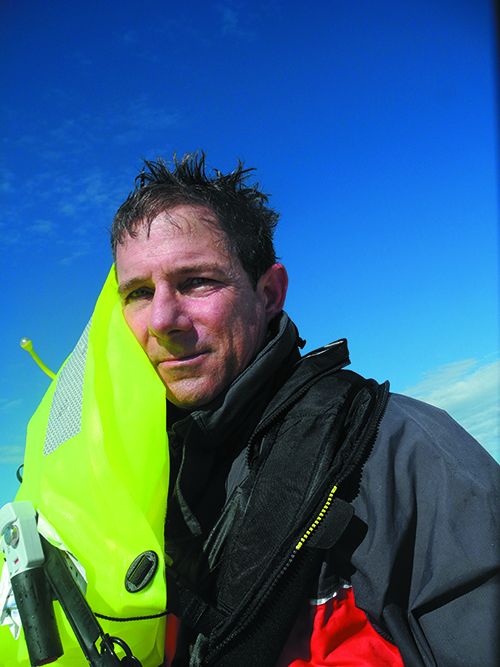
A significant amount of effort has been given to the development of life jackets that sailors will wear. The latest inflatable life jackets often include a harness and help keep a sailor tethered to the boat. If they do go overboard, the PFD theoretically delivers the buoyancy needed to keep the victim afloat and visible—expediting a rescue.
However, there’s one potential usage that’s had much less scrutiny. It’s a hazardous self-rescue scenario that arises in certain types of abandon ship incidents. These situations often define the pathway to safety as a gauntlet run through breaking surf, and an inflatable PFD may not be your best bet. Our review of some of the tragic sailing accidents of the last decade reinforces this concern.
One of these tragic accidents involved the crew of the 32 foot sloop Uncontrollable Urge. A cascade of problems began to unfold when the race boat’s rudder blade sheared away from the stock. It was late afternoon and the northern end of San Clemente Island was growing larger and larger. The crew tried to steer using sail trim augmented with propeller thrust. It didn’t work. Next came efforts to make up an emergency rudder and finally, in desperation, two light anchors were deployed. All attempts to regain control failed and a long overdue Mayday call to the Coast Guard was finally transmitted. It would take a helicopter over an hour to reach the scene. But just as the sun was setting, the sloop and her six person crew, entered the surf zone at the northern end of the island.
Uncontrollable Urge was driven hard onto a rocky offshore ledge. A particularly large set of waves hit like a piledriver, knocking the boat flat and causing the rig to collapse around the crew. Four sailors were swept overboard (three carried away by the current). The fourth, with his harness connected to the boat, was washed into the water but remained tethered alongside, tangled in the rigging. An attempt to haul him aboard failed and he was cut free to swim for shore. The two crew remaining aboard would soon have to decide whether to stick with the vessel being demolished around them, or abandon ship.
In the minutes that followed, five of the six crew would stagger ashore. All wore inflatable PFDs but four of the five survivors indicated that, in the surf zone, the life jacket bladders tried to shift position, causing both lobes of the bladder to attempt to relocate to the same side of their head. The sailor who tragically perished was found with his inflatable vest shifted into this position. Several of the crew said that making it to shore had been a very close call.
The last two sailors to abandon ship put a large rectangular foam fender to good use. It added extra buoyancy and helped significantly in getting them to shore safely. Another crew member was able to make his way to the inflated life raft that had torn free during the knockdown. He clung to the raft’s exterior and washed his way onto the rocky beach.
In the follow-on scrutiny of the incident, the life jacket manufacturer stated that their offshore rated inflatable vests were never intended for such use. This raises a major question regarding what should be worn, or used as a life jacket, when it’s time to abandon ship and the surf zone is the only shortcut to safety?
Such encounters are not unheard of. Three similar sailing accidents quickly come to mind. They involve the vessels, Low Speed Case (see Inside PS blog, “U.S. Sailing Releases Report on Farallones Accident”), Aegean and the big 66 foot sloop PWC. In total, 10 sailors perished in these encounters, all attempting to make their way from a grounded vessel to the nearby shore.
Finally, reconsider your life jacket requirements, especially if you’re long distance cruising or racing along a surf swept, rocky, coastline.
The abandoning ship process is in many ways a sequel to fire fighting aboard a sailboat. In the latter case, the basic minimum US Coast Guard fire suppression equipage for a 40-65 foot sailboat are one B-1 and one B-2 (or 3 B-1) fire extinguishers. Three B-1 fire extinguishers gives a person a total of 30-40 seconds worth of fire extinguisher flow. This short duration of fire-fighting capability is minimal and the reason why many sailors augment it with fixed engine room extinguishers and higher capacity portable extinguishers. The same logic holds true for abandon ship gear.
In addition to having a frequently worn, comfortable inflatable PFD/harness, follow Mark Bologna’s advice and add a USCG/SOLAS Type I to your safety kit. Also include a neoprene wet suit and swim fins. Or as commercial mariners have learned, perhaps even a dry suit or survival suit.
The higher in latitude you sail, the later in the season you cruise and the more time you spend on the water, the greater the cumulative risk. A well-maintained inflatable PFD may be the right answer day sailor on Long Island Sound. But those heading further afield should consider hedging their bet.
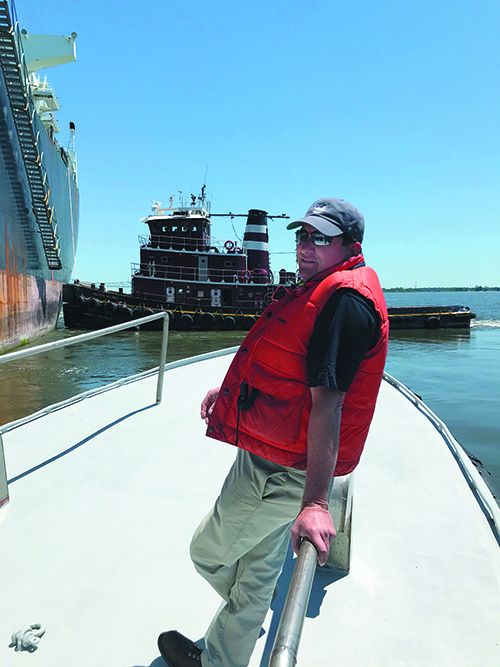
Ted Parish is an experienced coastal and offshore sailor with a very legitimate argument in favor of foam, inherently buoyant, life jackets. His day job involves safely piloting merchant ships up and down the tight confines of the Delaware Bay.
He’s a senior bay pilot who understands the risks involved in climbing from the pilot boat’s deck, just a few feet above sea level, to the rail of a merchant ship that may be 30 feet or more above its waterline. It takes a strong grip and a good sense of balance to negotiate the rope ladder. Add the swell from a nor’easter, ice on the deck and darkness, and one misstep can lead to an overboard incident.
From Ted’s perspective, an inflatable lifejacket’s inflation lag, often up to 10 seconds or more, is viewed as unacceptable among many mariners. Parish favors instantaneous, floatation that’s available 100 percent of the time. A delayed or even complete auto-inflation failure may be acceptable to those sailing in warmer water. There is a manual tab to pull and if that also fails, an oral inflation tube offers a last resort. However, in colder Chesapeake Bay winter water, or in mid summer conditions in Maine, Nova Scotia or the Pacific Northwest, a person in the water will be more likely to experience laryngeal spasms and have a hard time breathing let alone be able to orally inflate a PFD.
Sailors are starting to wonder how often the auto-inflation feature on inflatable life jackets fail? The industry doesn’t have an answer. But moderators of US Sailing Safety at Sea Seminars have for several years been informally, and now more formally, tracking these numbers.
It’s done by monitoring participants in their “hands-on” training program. Students jump into the pool, wearing their own inflatable PFD. At almost every session some fail to function properly. It’s a small number and the trend is around two or three per session. This is why we at PS recommend treating the device like a manual inflation PFD and advise users to immediately reach for the yellow tab and pull. If the auto-inflator beats you to the pull, that’s great. If not, your tug will initiate inflation.
Feedback from seminars also indicates that there are incidents when a double failure occurs and even a tug on the yellow tab does not result in inflation. These are often linked to poor maintenance and even owner failure to replace an empty CO2 cylinder. The oral inflation tube does offer a third way to attain some buoyancy. But when a victim is in extremis, traumatized by having fallen overboard, contacting cold water and wearing a life jacket with no floatation, the effort to orally inflate the life jacket is like singing as you sprint to the finish line of a 10-kilometer foot race.
Think of it this way. Those headed to a safety seminar are more likely to have checked out their inflatables and made sure that they are in good operational order (see Inside PS blog “Inflatable PFD Care and Use”). That said, there have been reports of a 2- to 4- percent failure rate, and it’s likely that it would be higher in random sampling in the field.
The reason we still support the inflatable idea is that they are comfortable to wear and even more importantly, when combined with a harness, tether and jackline system there’s a whole other level of safety added to the mix.
Consider a situation in which a vessel and crew are in an emergency, when the boat is being driven onto a surf-swept lee shore and the skipper decides that it’s time to abandon ship. In such a situation we recommend careful thought be given to donning a Type 1 USCG or SOLAS approved life jacket, and if time permits adding the wet suit and surf fins mentioned in the adjacent article. Safety lies in the transit through the surf zone—a survival route understood by the makers of old cork life jackets, but a pathway that’s apparently not part of the design capability of all inflatable life jackets.





























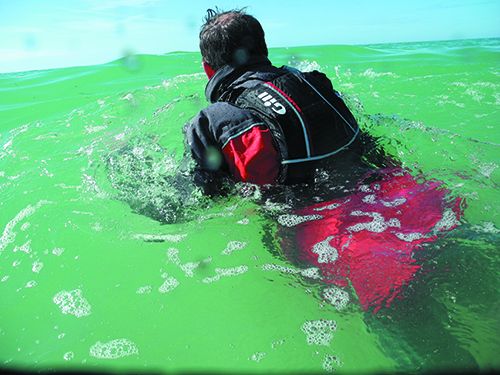





Good article.
I kayak in all seasons and conditions, summer and winter, flat water and rough. Though I will always have a PFD with me, I have no use for inflatables. If I capsize without wearing a PFD I can reboard. Depending on the kayak, this varies from simple to difficult and is a skill that must be practiced. Personally, I know I can reliably reboard in rough water and mild whitewater. If I fail, I know from practice I can easily don a PFD while swimming. If the water is very rough, I’m already wearing it, and I know I can reboard that way too. If it is very cold, I’m wearing a dry suit.
However, I have no chance of reboarding wearing a type I or an inflatable. The bulge in the front makes it practically impossible in conditions rough enough to cause capsize. I would have to either wait until rescued–dubious since I am often solo–or deflate before reboarding.
This is why special purpose vest, like paddling jackets, exist. I see a lot of inflatable PFDs on kayakers, but I don’t quite understand how it works for them. I’m guessing they haven’t thought it through.
It’s important to understand that nearly all Type 1 and inflatable PFD’s are “victim vests” designed to keep an unconscious or non-swimming victim face-up in the water. Type 1’s have more inflation so they work better in larger waves. But swimming with all that flotation on your chest if VERY difficult in anything other than a Safety @ Sea seminar pool.
If you actually might need to swim, to rescue yourself or others, you really want a Type III dinghy vest. Less flotation than an often rules required Type I, but perfectly adequate for a conscious swimmer in any conditions if you’re under 200lbs. A wet suit would be nice, but good luck getting one in an emergency situation.
Inflatables are great for those days when you generally don’t see the need for wearing a PFD or a foam vest is impractical. But the 10% failure rate often seen at Safety @ Sea seminars is simply mind blowing.
I think it’s fair to say that PFD regulations are NOT designed for experienced sailors. They are designed for large ship passengers who have no idea or expectations of ever swimming for their lives.
When kayaking you should ALWAYS wear a PFD. In the event of a capsize, the first line of defence is an eskimo roll. If that doesn’t work, you have to bail out of the kayak (upside down). Trying to put on a PFD when you come to the surface will almost certainly fail. As well, the PFD should be one designed for paddling, such that it allows ready movement of the arms. It should be one with inherent buoyancy, not an inflatable. When I sail with others, I wear an inflatable PFD. When I sail solo, I wear my kayaking PFD, which has in one pocket a handheld VHF and in the other a PLB.
Fantastic article. I use a Spinlock DeckVest 5D about 3 years old.
Has this fest been modified to solve the problem of both inflatable tubes migrating to one side of the head. I’ve heard of this problem but I don’t know if it’s been locked ever addressed it? Does it still exist in the current vests?
For me, I want crotch straps, a harness, and a tether in addition to buoyancy.
If I need to abandon ship, I want to attach to other people, gear, etcetera.
First article that I have read suggesting “swim fins”. I have always had a pair with me simply because it makes good sense. I always wandered why this has not been addressed more often.
Great article, eye opening.
All excellent points. Here’s another take on why to have foam PFDs on board. If you have six crew, all wearing their inflatables, and one throwable, and no foam PFDs, you’re complying with regulations. If one crew removes their PFD, you’re no longer in compliance. And, if you successfully recover a MOB, you have a discharged PFD, so you’re one short, until you install your re-arm kit. Two crew inflate, during that MOB recovery, does each have a re-arm kit? Off watch, hot bunking below, remove your inflatable and use the foam one as a pillow! Maybe not a Type I as a good pillow.
I received a surprise a few years ago. I’d worn a West Marine offshore auto inflate PFD for years, and, when it expired, decided to try it out on a nice, sunny day, prior to installing a new disc and cartridge. I am a fairly normal build, 6’2”, and the vest was properly worn and adjusted. I am also a strong swimmer with certification in rescue swimming.
When it inflated, I found it pressing – hard – on my carotid arteries. I have a martial arts background, and am aware how fast someone can lose consciousness in that condition, and grabbed the edge of the left side bladder, holding it off my neck, as I was starting to feel the weird tingling that signaled that I might be about to pass out – I was also finding it hard to breath. I’d jumped off the side of my sailboat, and by the time I’d awkwardly swam to the boarding ladder at the back, I was getting a bit panicky. I grabbed the manual inflate tube to vent air and discovered the next problem – the vent mechanism had retreated down the tube and couldn’t be operated!
My wife and friends on the boat had been laughing and cheering me on, unaware of any problems. I climbed back onto the boat and yanked the vest off, gasping for breath, and tried the vent again, finally getting it to work much later, after jamming a long, thin, screwdriver down the tube.
I still wear an auto inflate PFD (from a different manufacturer) but the experience was very eye-opening. I know the re-cert kits are expensive, but everyone should try out their vest under benign conditions before you take it into rough weather. I shudder to think of the same thing happening in the dark, in cold, rough water. The only other option I really had was to unclip the harness, which could result in losing it in rough weather, although, as I was clawing at my boarding ladder, I was actually thinking of yanking out my knife and puncturing the bladder, which shows you the state of mind I was in after a brief period of being throttled by my PFD.
Test your vest!
I seriously doubt that ‘Ted Parish, a professional harbor pilot, relies on an inherently buoyant PFD’ will survive if he is unconscious in the water. A buoyant vest, and no additional buoyancy under the head/neck.
My life vests include a Type 1 for abandon ship and a Spinlock for regular use, plus for older weather sailing, a Mustang Survival flotation coat and a Mustang Survival jacket both with flotation hood.
I want what works whether I am conscious or not. Always assume three things might be in effect when someone goes in the water: injured, hypothermic, unconscious. I have a Stearns Merchant Mate II. Lifesaving equipment should have minimum parts and work without a fuss. No pulling strings or complex mechanical parts, cylinders, etc. 20+ years in the CG taught me that simple works when lives count. Which is why life rings or a simple system like a LifeSling work so well.
My word, how you do complicate everything ! It’ simple, DON’T FALL OFF ! I’ve been sailing for over sixty years, most of them as a skipper of one sort or another, tiny boats to 70 feet. I have NEVER had anyone fall off any boat under my command ; by the simple method of requiring (not suggesting !) that lifejackets MUST be worn and harness hooked on before mounting the companion into the cockpit when at sea, even when just offshore or about to be. The only exception being on a very calm sunny day on a calm sea when everyone stays in the cockpit, the risk then being too minimal to justify discomfort and inconvenience, and the spoiling of the ladies’ suntans ! On passage NO-ONE leaves my cockpit without being properly hooked on, and checked by someone else. If the boat has no safety wires along the deck, use the lower safety wires between the stanchions and use the two carbine hooks to transfer from one section to the next. But fastening points well inboard or on the centreline are greatly preferable. In inland waters, the rules can be much relaxed, and I only require lifejackets to be worn in crowded waters or when danger is foreseen. Harness in such waters seems to be excessive, retrieval being very much easier than at sea ; where it’s usually almost impossible in the conditions when MOB is likely to happen (despite all the fancy theories and expensive gear) to those who haven’t the sense to HOOK ON ! If people don’t accept that this is for the safety of their lives, then let them sail with someone else ; who will doubtless take great interest in your excellently comprehensive article ! I apologise if any of this gives any offence, none is intended, only well-meant and experienced advice. Boringly, I repeat : DON’T FALL OFF ! !
Out at sea a proper safety harness is way more important than the PFD, and with proper I mean a harness that makes sure you do not drown being pulled alongside your boat, but that makes sure your face is clear of the water. In the past the French sailing school Les Glénans had such a lifejacket made with fixe buoyancy and more recently TeamO Marine in the UK launched the Backtow® lifejacket.
Can you provide a link to the sinking of the 66ft vessel “PWC”? I am familiar with the other sinkings, having read the reports, but not with this one.
A quick Google search failed to turn up any information, largely because the name PWC brings up all sorts of unrelated hits.
In my view:
1. Do not fall off the vessel.
2. If you fall off for any accidental reason, be wearing a PFD that is reliable, up-to-date, properly adjusted, and not of the sort that will make things worse for you.
3. I believe carrying an assisted opening knife on a lanyard is advisable at all times while sailing.
4. It is up to the Captain to follow and enforce the rules at all times.
5. If you go overboard, pray (no advice on how or to whom, but the old saw about foxholes probably applies).
6. Hope for and implement PFD improvements before you fall.
7. REREAD the article now. It is good. So are the earlier comments.
Thank you for all of this. It helps us remain centered on safety. Thank you also for the comments from other readers.
Thanks for another great article on PFDs and safety in general. It seems clear there’s room for innovation in personal flotation. Keep pushing the manufacturers to do more.
I teach sailing in open Longboats and also sea kayaking. I comfortably wear a type III sea kayaking vest in virtually all conditions. I would happily wear it on board my NorSea but when it gets sporty I really want to be clipped in with a harness and the two are incompatible. White water rescue vests do have a harness, but the D ring is on the back. This is good for being held against a current (or being towed by a boat) because it keeps your mouth out of your own bow wave, but you want a front attachment for working on deck or staying attached in the first place.
My ideal PFD would be a type III vest that incorporated a D ring front and back, with removable leg loops. The sea kayaking or fishing styles have pockets that are useful for things like VHF, PLB, light, sunblock or snack, but anything that sticks our from the vest itself will get in the way during re-entries. A rescue knife mounted on the tab provided is ready at hand but will also snag any line in the vicinity.
Pockets could be recessed, knives can be mounted elsewhere and still be handy. Tethers could be attached in back and then in front with a quick release. The newer kayaking PFDs have most of the flotation on the front and across the shoulders but not in the lower back, which should help keep you face up. Add a flotation collar to support your head, a pull out hood, mountings for a PLB and a light that would be visible yet not blind you, and there you go: an offshore PFD you can work in, swim in, clip in, or relax in. Come on designers, make it happen!
To accommodate all the personal safety gear recommended in this article (i.e.comfortable inflatable PFD/harness, USCG/SOLAS Type I, neoprene wet suit, swim fins, and perhaps even a dry suit or survival suit) for me and each of my crew, I gotta get a bigger boat! Oh damn, a bigger boat means more crew which means more gear which means an even bigger boat!
On second thoughts, I might just sell my current boat and spend the money going (more often than I go sailing) to the local water park where there are multiple avenues for fun and lifeguards every 5 yards to rescue me should I get into trouble, paramedics just minutes away and hospitals nearby!
Ralph- We met a few years back at a seamanship seminar in NYC and then had you speak at a Power Squadron event. Like others in the thread, I enjoy your sage advice on safety. You raise topics many of us have not thought about, had reason to think about, or even surmise. Your article has prompted me to equip my boat differently. A focus on prevention and safety is a good thing. Getting the word out on these topics with stories and anecdotes makes them real, memorable and easy to pass along to others in casual conversations. Safety – one person at a time – is fine by me since you’re moving the needle to the right and raising the bar. Thanks again for your articles and contribution to the community at large and know that your articles get consumed voraciously.
I Have done multiple Transpacs and do not need to remind you that the rule is simple:” if you are topside, you are clipped in via your harness and tether, with an inflatable or standard PFD, or you stay below decks, NO EXCEPTIONS. I have been on deck wrestling with errant sails enough, wearing only my PFD and clipped in harness, in my underwear. I have been washed-about on deck, but never over the side. I have been bashed in the head by a boom in an accidental jibe, while clipped in, and did not go over the side. This while being 1250 miles off shore. Grow up, wear your safety equipment or stay on shore. You will not be welcome aboard otherwise.
The one year I had a powerboat (2021) I involuntarily went overboard during a fire. The automatic inflator worked immediately, but the huge, hard inflated compartments prevented me from boarding my inflatable boat, and for that matter, nearly eliminated me from being able to swim because of the hardness and shape, think (44 triple E). Reaching the well hidden buckle while in somewhat of a panic mode was not only not on my mind, but even when ashore, was pretty darn difficult. I’m going to be looking at waist belts, or more conventional, functional life vests, but even with hose I’ve experimented with, the lack of a crotch belt causes those to ride up and be a hindrance in their own right. I’ll be searching for one with that important component.